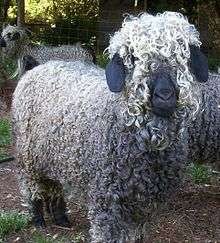Angora goat

The Angora goat (Turkish: Ankara keçisi) is a breed of domestic goat that is named after Ankara, Turkey, historically known as Angora. Angora goats produce the lustrous fibre known as mohair.
History
The Angora goat has been regarded by some as a direct descendant of the Central Asian markhor (Capra falconeri).[1][2] They have been in the region since around the Paleolithic.[3] Angora goats were depicted on the reverse of the Turkish 50 lira banknotes of 1938–1952.[4]
Introduction to Europe
The first Angora goats were brought to Europe by Charles V, Holy Roman Emperor, about 1554, but, like later imports, were not very successful.
Introduction to Australia
Angora goats were first imported into Australia in 1832 and 1833. They came from M Polonceau's stud in France to the property of the Riley family of Raby, New South Wales. Pure bred Angoras were imported from Ottoman Empire in subsequent years up to 1873, to properties in New South Wales, Victoria, and later South Australia. Other states followed and there were importations from South Africa in 1873 and from USA between 1890 and 1910.[5]
Angora goats were introduced to New Zealand in approximately 1867 by the Auckland, Canterbury and Otago acclimatisation societies in an attempt to farm animals with more valuable skins.[6] Angora goats initially struggled to gain a foothold but were unsuccessfully trialed for weed-control purposes at Maungaturoto in 1904 and, following escapes, a feral population established at Waipu while a government herd was established at Helena Bay and occasionally improved with Australian genetics. More recently, South African and Texan genetics were sourced to improve the New Zealand Angora.[7]
Introduction to South Africa
In 1838, Sultan Mahmud II of Ottoman Empire sent twelve neutered rams and one female to Port Elizabeth in South Africa. The rams were rendered infertile as the Sultan wanted to protect his country’s powerful mohair empire. However, the ewe on board was pregnant and gave birth to a kid ram en route to Africa, which was the start of the industry in South Africa. Today’s Karoo region produces the most mohair in the world.[8]
Introduction to North America
Angora goats were first introduced in the United States in 1849 by Dr. James P. Davis. Seven adult goats were a gift from Sultan Abdülmecid I in appreciation for his services and advice on the raising of cotton. More goats were imported over time, until the Civil War destroyed most of the large flocks in the south. Eventually, Angora goats began to thrive in the southwest, particularly in Texas, wherever there are sufficient grasses and shrubs to sustain them. Texas to this day remains the largest mohair producer in the U.S., and third largest in the world.
Characteristics

The fleece taken from an Angora goat is called mohair. A single goat produces between four and five kilograms of hair per year. Angoras are shorn twice a year. Angoras, despite their coats, are not directly related to sheep.
Turkey, Argentina, the United States, and South Africa are the top producers of mohair.[9] Secondary producers include New Zealand[10] and Australia. For a long time, Angora goats were bred for their white coats. In 1998, the Colored Angora Goat Breeders Association was set up to promote breeding of colored Angoras.[11] Now, Angora goats produce white, black (deep black to greys and silver), red (the color fades significantly as the goat gets older), and brownish fibers.
Angora goats are more susceptible to external parasites (ectoparasites) than similar animals, as their coats are denser. They are not prolific breeders, nor are they considered very hardy, being particularly delicate during the first few days of life. Further, Angoras have high nutritional requirements due to their rapid hair growth. A poor-quality diet will curtail mohair development.
See also
| Wikimedia Commons has media related to Angora goat. |
References
- ↑ John Lord Hayes (1868). The Angora goat: its origin, culture and products. Boston, 1868
- ↑ Olive Schreiner (1898). Angora goat ... : and, A paper on the ostrich ... London : Longmans, 1898
- ↑ Carol Ekarius (10 September 2008). Storey's Illustrated Breed Guide to Sheep, Goats, Cattle, and Pigs: 163 Breeds from Common to Rare. Storey Publishing. p. 150. ISBN 978-1-60342-037-2.
- ↑ Central Bank of the Republic of Turkey Archived 2009-06-03 at WebCite. Banknote Museum:
2. Emission Group – Fifty Turkish Lira – I. Series;
3. Emission Group – Fifty Turkish Lira – I. Series & II. Series. – Retrieved on 20 April 2009. - ↑ http://herdbook.mohair.org.au/dnn/Home/History/tabid/68/Default.aspx[]
- ↑ http://www.teara.govt.nz/en/goats-and-goat-farming/page-2
- ↑ History of New Zealand Angora Goat Farming at Waipu Angoras
- ↑ http://www.mohair.co.za/page/mohair_story
- ↑ South African Department of Agriculture, Forestry & Fisheries, 2011
- ↑ http://www.teara.govt.nz/en/goats-and-goat-farming/page-4
- ↑ http://www.cagba.org/